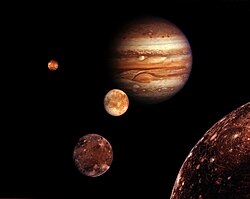Images
- Europa is thought to have a subsurface ocean.
- False-color image of Ganymede
- Mimas has a density of 1.1 g/cm3.
- Active plumes on Enceladus
- False-color image of Titan showing surface and atmospheric details
- Miranda has a scarred surface.
- A potential frost deposit on Umbriel's pole
- A cloud over the limb of Triton










